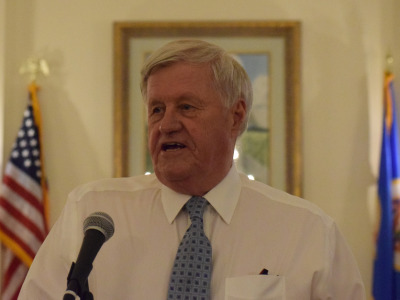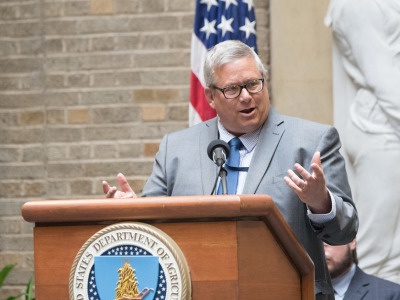Democrats are preparing to pour money into federal conservation programs as a key way to pay farmers to address climate change. Converting marginal croplands to grass through the Conservation Reserve Program is one way to do it, but the question is whether USDA can get landowners interested in CRP again.
Enrollment in the 35-year-old program has been in steady decline for more than a decade and is now at its lowest level ever as prices of corn, soybeans, cotton are reaching heights farmers haven’t seen for several years.
Fewer than 20.8 million acres are currently enrolled in the program — far short of the 25 million acre limit set by Congress for fiscal 2021 — and 3 million of the existing CRP acres are in contracts set to expire Sept. 30, with another 4 million acres due to leave in 2022.
By comparison, there were 36.8 million acres enrolled in CRP in 2007, the year the current Renewable Fuel Standard was signed into law, helping ignite a boom in corn and soybean demand that prompted many landowners to pull land out of CRP and put it back into crop production.
The Biden administration has extended a signup started in December while USDA officials look for ways to make the program more attractive. Tom Vilsack, who could take over as agriculture secretary as soon as next week, said in an interview in January that expanding CRP will be one of his climate policy priorities.
Wildlife conservation groups say the Trump administration depressed interest in CRP by cutting payment rates and other financial incentives excessively.
But it’s far from clear that Vilsack can significantly boost interest in the program simply by making adjustments to payment rules.
Former House Agriculture Committee Chairman Collin Peterson, who is in talks with lobbying firms about working on agriculture and climate policy, says Congress should increase the acreage limits on CRP significantly, using money provided by a climate bill, and mandate that USDA enroll enough acreage to meet the caps. That would be a dramatic change in CRP policy; USDA isn’t required now to meet the enrollment caps.

Former House Ag Chair Collin Peterson
Expanding CRP "is the most surefire way to a significant reduction” in agricultural greenhouse gas emissions, Peterson said. Land planted to grass under 10-year or 15-year CRP contracts keeps carbon in the soil that would otherwise be released through tillage, and it also avoids emissions of nitrous oxide that result from applying nitrogen fertilizer to crops. Existing CRP acreage is sequestering an estimated 49 million tons of carbon, the equivalent to taking 9 million cars off the road, according to USDA.
“Let's tweak this to make it farmer friendly, to make it climate friendly, and if we have extra money, use that money to make sure these programs work,” said Peterson.
By comparison, U.S. agriculture was responsible for 629 million metric tons of emissions in 2019, or about 9.6% of total U.S. emissions, according to the Environmental Protection Agency. Nitrous oxide emissions from crop production accounted for 58% of ag's carbon footprint.
One political benefit of expanding CRP is that it could benefit farmers and landowners in drier areas of the country where producers may have a harder time earning credits through practices such as cover crops.
After losing election in November, Peterson introduced legislation to mandate that USDA enroll up to 50 million acres in CRP. His intention, he says, was to ensure that expanding CRP would be a key part of the climate debate.
But he acknowledges that expanding CRP faces political as well as practical challenges. Grain processors and livestock producers have long resisted increases in cropland retirements that significantly increase commodity prices. Advocates for beginning farmers say expanding CRP makes it harder for them to find acreage. And then there’s the question of how you get landowners to enroll acreage without substantially increasing CRP payment rates to above local land rental rates.
Peterson believes USDA should target “marginal land that probably shouldn't have been farmed in the first place and pay a decent rental rate … in excess of what they can get renting it out for farmland.”
But he concedes that there is a “fine balance” between paying too little for CRP acreage and paying so much for it that local farmers can’t obtain the land they need. “If you go out there and pay too much then you get a backlash … from within these local communities,” he said.
The 2018 farm bill required reductions in CRP payment rates as a way to offset the cost of gradually increasing the enrollment cap from 24 million acres to 27 million acres and to address complaints that CRP payments were exceeding local rental rates in Iowa and other areas. (The limit rises to 25.5 million acres for FY21.)
Interested in more news on farm programs, trade and rural issues? Sign up for a four-week free trial to Agri-Pulse. You’ll receive our content - absolutely free - during the trial period.
Payment rates are now generally capped at 85% of county average rental rates for acreage enrolled under the general signup and at 90% of local rental rates for more environmentally sensitive land enrolled under the continuous sign-up.
Wildlife groups say the Trump administration had flexibility with the payment caps that it didn’t use — the farm bill didn’t require the caps to be applied to new CRP contracts — and USDA cut some incentive payments more than it had to. For example, USDA can legally provide practice incentive payments of up 50% of the practice cost; instead, the department limited the amount to 5% for most of 2020. In December, USDA announced it would increase the rate to 20%. There are currently 6.4 million acres of CRP land enrolled under continuous signup.
“We were surprised to see the cuts that went beyond the intent of the farm bill,” said Jim Inglis, director of government affairs for Pheasants Forever. He said for some landowners, the payment caps mean CRP will pay less than it did 10 to 15 years ago.

Former USDA Undersecretary Bill Northey
Bill Northey, who was USDA’s undersecretary for farm production and conservation during the Trump administration, says the department was trying to carry out the intent of Congress to keep CRP from overpaying landowners and providing excessive cost-share assistance for seeds.
“You have to be very careful about overpricing CRP so that people decide to do that because it just pays a little more,” Northey said.
“The return should be there so that people can do good conservation practices … and still get an economic return, but it shouldn’t be at a place where it’s taking land out of production, and landlords are retiring and taking it away from existing tenants.”
But there’s also a time lag between when rental rates are surveyed and when land goes into CRP that makes it challenging for USDA to set payment rates, says Northey. Payment rates for the current general sign-up are based on rental rate surveys done in 2019. Newly enrolled land won’t enter the program until this fall.
Northey said he isn’t entirely sure why interest in the program has been lagging in recent years — or what it will take to expand the program significantly, especially when commodity prices are surging. USDA re-enrolled a portion of the 4.4 million acres that were in contracts that expired last September and wound up with a net loss in the program at the end of the year of about a million acres.
A year ago, USDA was projecting that farmers would make an average of $3.85 a bushel on their 2021 crop. The average price of the 2022 corn crop is now forecast at $4.30 a bushel, and futures prices are much higher than that. Corn for March delivery was trading for more than $5.50 a bushel on Tuesday.
“There is an inherent challenge (in enrolling CRP land) in times of high prices, where people can be profitable in farming and renting the land out,” Northey said.
For more news, go to www.Agri-Pulse.com.


